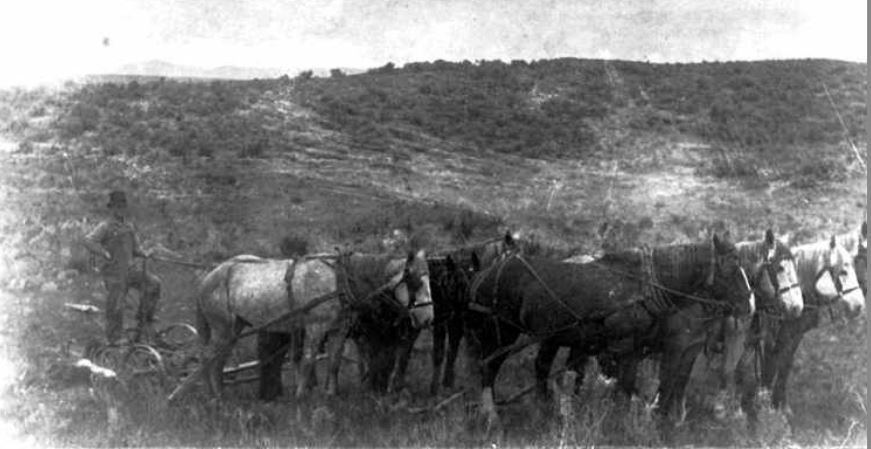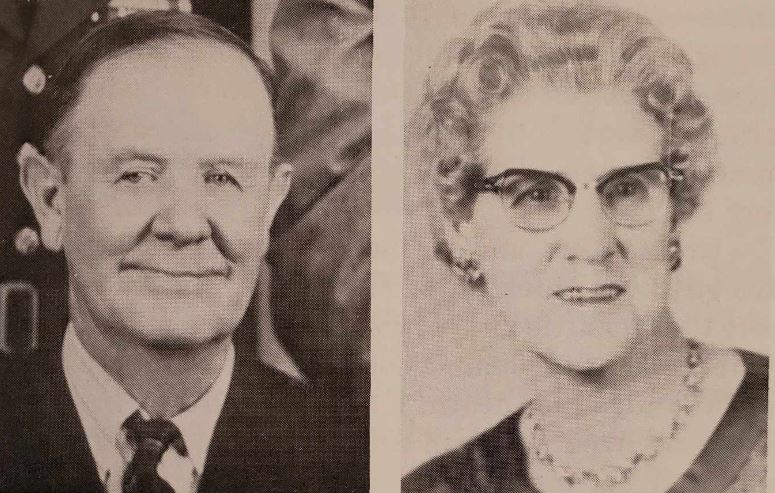David Thomas Lusk



David Thomas Lusk and Susannah Bailey Lusk
David Thomas Lusk was born on 25 November 1888 in Malad, Idaho in a one-room log cabin. His parents were John Winters Lusk Jr. and Annie Eliza Thomas, Arbon Valley homesteaders. He was the third child but first son. He was later joined by three more sisters and two more brothers, including his brother, Edward “Park” Lusk, who played a big part in his life.
According to the book, Bannock Valley, “When [David] was eighteen years old, he started to work for L.L. Evans on the Fort Hall Bottoms. He fed about a thousand head of cattle through the winter. In the summer he would cook for seventeen hay men and sharpen hay knives for the mowing machines. They would start mowing the first crop alfalfa in late June and not stop haying until they had finished the wild hay and second crop alfalfa in late August or early September†(p. 222).
When he turned twenty-one, which was the legal age to homestead, Dave applied for 160 acres of his own near the eastern mountains bordering Arbon Valley. Over time he acquired several other pieces of land from homesteaders who had proved up and then decided to move out of Arbon. After his marriage, he and Park bought the ranch from their parents in 1927, and several years later Dave bought out Park’s share.
Despite the long distances between neighbors in Arbon Valley, the residents managed to get together often no matter what the weather. One of the favorite pastimes in the summer months was baseball. The different areas of Arbon had teams, and not only played each other but also played teams outside the valley, such as the teams in Holbrook, Malad, and Arimo. David and his brother Park were on the Pauline team and were well known for their athletic abilities.
A former resident, Nina Keeler, remembers one Arbon party that almost became Dave’s funeral, when Arbon Valley reflected a time of the more wild West reflected in movies. She remembered the party as being a 24th of July celebration, but didn’t remember the year. “Dave Lusk and Oscar Randall…got into a fight and Oscar pulled a gun on Dave. Everyone knew Dave but Oscar was a newcomer. My dad [Ed Keeler] knew Oscar…was from Kentucky and [that] he could ride his horse at a full gallop and shoot every fence post as he rode. They asked Dad to get the gun away from Oscar. We were scared to death but Dad did get Oscar to give him his gun. It was a beautiful gun with a pearl handle. Dad kept the gun for about a month and then gave it back to Oscar†(Bannock Valley, p. 215).
David married Susannah (“Annieâ€) Kerr Bailey on 24 December 1913 in Pocatello, Idaho, when he was twenty-five and she was twenty. They courted in the iconic white-top buggy. Susannah was the daughter of James Bailey and Annie Leishman Kerr Bailey, who were also Arbon homesteaders. Like her husband, Annie was also the third child.
On an interesting note, Annie’s younger sister Erma married David’s younger brother Edward “Park†Lusk in 1918, so their children were destined to be double cousins.
Like many families of the time, Annie’s family had experienced a lot of tragedy. Her oldest sister Jennie had died in childbirth in 1912 when Annie was nineteen. Jennie had married John Lawrence Gibbons in 1910, and her pregnancy in 1911-1912 was her first. But the happy expectation of this pregnancy was not to be: baby Bertha died the day she was born, and then Jennie died also. Jennie and the baby were buried together in the same casket in the Arbon Cemetery. Their deaths occurred in late March when there was still several feet of snow blanketing the cemetery and the ground underneath was frozen hard, making it almost impossible to dig a grave.
Almost exactly ten years later, another of Annie’s beloved sisters died – this time, it was Park’s young wife. Erma had married at age seventeen, had two babies in the next few years, and got the flu at age twenty. She was too sick to be taken to the hospital as her family knew the journey in winter over the rough roads would surely kill her. Regardless, she died on 24 February 1922. Hers was another winter funeral and burial. Her father dug through the deep snow and frozen ground to make her final resting place next to her sister Jennie. What a sad funeral that must have been for her husband, little boys, parents, and neighbors. Her two sons were aged one and three.
At the time of Erma’s death, David and Annie’s family consisted of John Paul, age eight; and Jennie Louise (named for Annie’s sister who had died in 1912), age five. In between the birth of their two living children, they had had a baby girl in January 1916, but she lived less than a day. They then had David Wayne, 1919; Vernon Neal (“Budâ€), 1925; and a caboose, James Glen (“Mickâ€), 1932. So in the end, they had a family of five boys and one girl, plus their two nephews.
It was a natural fit that David and Annie would raise Park and Erma’s two motherless boys, James Park, born in 1918, and Ralph Bailey, born in 1920. Since David and Park were brothers, and Annie and Erma were sisters, the children from both sets of parents were double cousins. Park would remarry again seven years later, in 1927, but the boys continued to be raised by their uncle and aunt. Park lived close by, so they went back and forth often.
All the children attended all eight grades of the Pauline Elementary School. They attended church in the Pauline LDS Church, then called the Meadow Ward, which used to stand at the end of Lusk Loop.
Annie did not drive. According to her son, David Wayne, one time she went to drive the Model T to the post office a mile down the road to take a can of cream. These were five gallon cans, and at that time the mail man would help out the Arbon residents by taking the cream to Pocatello to sell. “When she went to stop she got confused and ran through the fence.” She drove back home and said she would never drive again – and she never did.
David Wayne paid tribute to his parents’ persistence and hard work: “The early years that Mother and Dad had the ranch were hard years, with very little money to buy the things that were needed. Most of the food was raised on the ranch. They had chickens for eggs and meat, cows for milk, butter and cheese. The milk was separated and the extra cream was sold in ten-gallon cans which were sent to the creamery in Pocatello with the mailman. The separated milk was fed with barley and wheat to the pigs to fatten them for market and to butcher for our meat supply. Each fall Dad would take wheat to the flour mill in Pocatello and trade for sacks of flour for our year’s supply – it took a sack a week [to feed our family]. Some years it took all the wheat [we could raise] for flour. They also raised alfalfa and wild hay to feed the milk cows through the winter†(Bannock Valley, p. 222).
David died from a rare fungus on his spine on 9 December 1953 in Pocatello at age sixty-five. He was laid to rest in the Mountain View Cemetery there. In a strange coincidence, Susannah died eleven years later in 1964 on the very same date, also in Pocatello. She was seventy-one years old. She was buried alongside her spouse in Mountain View Cemetery.
Their son David Wayne and his wife Bette Anne Neilsen Lusk bought the ranch from Annie after her husband died. David and Bette’s son and daughter in law, David N. and Helen Lusk run the ranch now, the third generation “David” to run the homestead.
Several other Lusk families continue to live in the valley, the fourth and fifth generations from the original Lusk homesteader, David Winters Lusk Jr. One of these families is Steve and CaroLynn Lusk. Steve’s job for decades was as manager of the Arbon highway department, and everyone certainly appreciated his work at keeping the roads clear.
Sources:
Ward, Laurie Jean, Bannock Valley (Providence, Utah: Keith Watkins and Sons, 1982).
https://www.familysearch.org/tree/person/details/KWZM-WZT
https://www.findagrave.com/memorial/44638054
The links provided here will lead to information on other family members.
